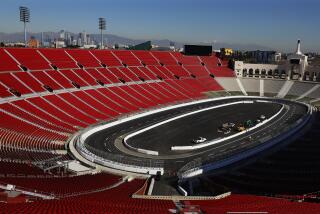40 Robots to Face Off in Fontana
- Share via
Let the battle of the machines begin again.
Forty self-navigating robots were chosen as semifinalists Monday for spots in the Oct. 8 sequel to last year’s first-ever robot race across the Mojave Desert.
Only half of the semifinalists will qualify for the starting line, based on how they maneuver -- without human help -- through obstacle courses.
Organizers of the Pentagon-sponsored race doubled the prize money to $2 million after none of the 15 contestants finished the rugged 150-mile course last year.
A converted Humvee by Carnegie Mellon University’s Red Team was last year’s top performer. It traveled 7 1/2 miles before breaking down.
Its team is back with another robot entry.
“This year is a dogfight. It’s going to be a real rumble,” said William L. “Red” Whittaker, a robotics professor at Carnegie Mellon University who leads the Red Team.
The semifinalists’ self-navigation skills will be tested in trials at California Speedway in Fontana from Sept. 27 to Oct. 5. The robotic vehicles must rely on global positioning satellites and various sensors, lasers, radar and cameras to orient themselves and to detect and avoid barriers.
The winner of the Oct. 8 final is the first robot to make it across 150 miles of desert between Los Angeles and Las Vegas in less than 10 hours. The exact course will be revealed two hours before race time.
Most of last year’s participants are among this year’s semifinalists. The teams, from 14 states and Canada, include individuals, universities, corporations and a high school. Nearly 200 teams applied this year.
Among the newcomers is the Stanford Racing Team, which is entering a converted Volkswagen Touareg nicknamed Stanley.
“It’s all about building a mind for the machine,” said team leader Sebastian Thrun, a computer science professor at Stanford University. “We believe it’s a software race, not a hardware race.”
The so-called Grand Challenge is sponsored by the Pentagon’s Defense Advanced Research Projects Agency to foster the development of unmanned military vehicles.
More to Read
Sign up for Essential California
The most important California stories and recommendations in your inbox every morning.
You may occasionally receive promotional content from the Los Angeles Times.













